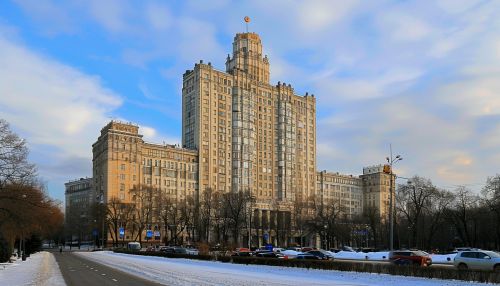State Planning Committee (Gosplan)
State Planning Committee (Gosplan)
The State Planning Committee, commonly known as Gosplan, was a central institution in the Soviet Union responsible for economic planning and the implementation of the state's economic policies. Established in 1921, Gosplan played a pivotal role in the administration of the Soviet planned economy, guiding the allocation of resources, setting production targets, and overseeing the execution of economic plans. This article delves into the history, structure, functions, and impact of Gosplan on the Soviet economy.


Historical Background
Gosplan was founded in the aftermath of the Russian Civil War, during a period of economic turmoil and reconstruction. The Bolshevik government, led by Vladimir Lenin, sought to transition from the war economy to a peacetime economy through centralized planning. The establishment of Gosplan was a key component of this strategy, aimed at coordinating the efforts of various economic sectors and ensuring the efficient use of resources.
Initially, Gosplan's role was limited to providing advisory services and statistical analysis. However, with the introduction of the New Economic Policy (NEP) in 1921, its responsibilities expanded to include the formulation of economic plans. The NEP allowed for a mixed economy, combining state control with limited market mechanisms, and Gosplan's task was to balance these elements to achieve economic stability and growth.
Structure and Organization
Gosplan was structured as a hierarchical organization, with a central committee at the top, supported by various departments and regional branches. The central committee was composed of senior officials appointed by the Soviet government, including representatives from key ministries and economic agencies. This structure ensured that Gosplan's plans were aligned with the broader goals of the state.
The main departments within Gosplan included:
- **Industrial Planning Department**: Responsible for setting production targets and coordinating activities in heavy industries such as steel, coal, and machinery.
- **Agricultural Planning Department**: Focused on the planning and development of agricultural production, including crop and livestock management.
- **Financial Planning Department**: Managed the allocation of financial resources and monitored the implementation of economic plans.
- **Statistical Department**: Collected and analyzed economic data to inform planning decisions and assess the performance of various sectors.
Regional branches of Gosplan operated at the republic and local levels, ensuring that national plans were adapted to the specific conditions and needs of different areas.
Functions and Responsibilities
Gosplan's primary function was to develop and implement the Five-Year Plans, which outlined the economic objectives and targets for the Soviet Union over a five-year period. These plans covered all aspects of the economy, including industry, agriculture, transportation, and social services. The planning process involved several key steps:
1. **Data Collection and Analysis**: Gosplan gathered extensive data on economic performance, resource availability, and demographic trends. This information was used to identify priorities and set realistic targets. 2. **Drafting the Plan**: Based on the analysis, Gosplan drafted a comprehensive plan that detailed production targets, resource allocations, and timelines for various sectors. The draft plan was reviewed and approved by the Soviet government. 3. **Implementation and Monitoring**: Once approved, the plan was disseminated to relevant ministries, enterprises, and regional authorities. Gosplan monitored the implementation of the plan, ensuring that targets were met and addressing any issues that arose. 4. **Evaluation and Adjustment**: Throughout the plan period, Gosplan evaluated progress and made adjustments as necessary to respond to changing conditions and unforeseen challenges.
Impact on the Soviet Economy
Gosplan's influence on the Soviet economy was profound, shaping the development of the country for several decades. The centralized planning system allowed for rapid industrialization, particularly during the 1930s under Joseph Stalin's leadership. The First Five-Year Plan (1928-1932) focused on heavy industry and infrastructure, leading to significant increases in production and the establishment of key industrial complexes.
However, the emphasis on heavy industry often came at the expense of consumer goods and agriculture, leading to imbalances and shortages. The collectivization of agriculture, a key component of the First Five-Year Plan, resulted in widespread disruption and famine, particularly in Ukraine during the Holodomor.
Despite these challenges, Gosplan continued to play a central role in the Soviet economy throughout the 20th century. The planning system allowed for the mobilization of resources during World War II and the subsequent reconstruction period. In the post-war era, Gosplan's focus shifted to technological advancement and the development of new industries, such as aerospace and electronics.
Criticisms and Challenges
Gosplan faced numerous criticisms and challenges throughout its existence. One of the main criticisms was the rigidity of the planning system, which often failed to adapt to changing economic conditions and technological advancements. The emphasis on meeting quantitative targets sometimes led to inefficiencies and waste, as enterprises prioritized quantity over quality.
The lack of market mechanisms also posed challenges, as the absence of price signals made it difficult to allocate resources efficiently. This often resulted in shortages and surpluses, with some goods being overproduced while others were in short supply. Additionally, the centralized nature of the planning system limited innovation and entrepreneurship, as decisions were made by bureaucrats rather than market participants.
Reforms and Legacy
In the later years of the Soviet Union, there were several attempts to reform the planning system and address its shortcomings. Under the leadership of Mikhail Gorbachev, the policies of perestroika (restructuring) and glasnost (openness) aimed to introduce elements of market mechanisms and increase transparency in the planning process. However, these reforms were only partially successful and were ultimately unable to prevent the collapse of the Soviet Union in 1991.
The legacy of Gosplan is complex and multifaceted. While it played a crucial role in the industrialization and modernization of the Soviet Union, its rigid and centralized approach also contributed to economic inefficiencies and stagnation. The experience of Gosplan provides valuable lessons for understanding the strengths and limitations of centralized economic planning.
